Cite this document
(Causes and Effects of the Global Financial Crisis Research Paper, n.d.)
Causes and Effects of the Global Financial Crisis Research Paper. Retrieved from https://studentshare.org/macro-microeconomics/1734464-the-recent-financial-crisis
Causes and Effects of the Global Financial Crisis Research Paper. Retrieved from https://studentshare.org/macro-microeconomics/1734464-the-recent-financial-crisis
(Causes and Effects of the Global Financial Crisis Research Paper)
Causes and Effects of the Global Financial Crisis Research Paper. https://studentshare.org/macro-microeconomics/1734464-the-recent-financial-crisis.
Causes and Effects of the Global Financial Crisis Research Paper. https://studentshare.org/macro-microeconomics/1734464-the-recent-financial-crisis.
“Causes and Effects of the Global Financial Crisis Research Paper”, n.d. https://studentshare.org/macro-microeconomics/1734464-the-recent-financial-crisis.


